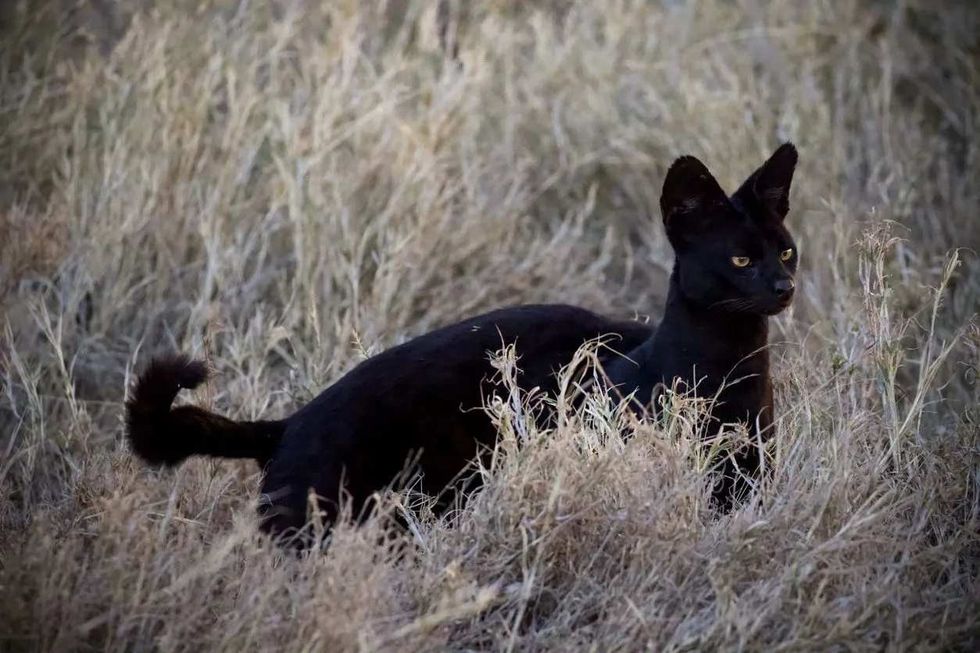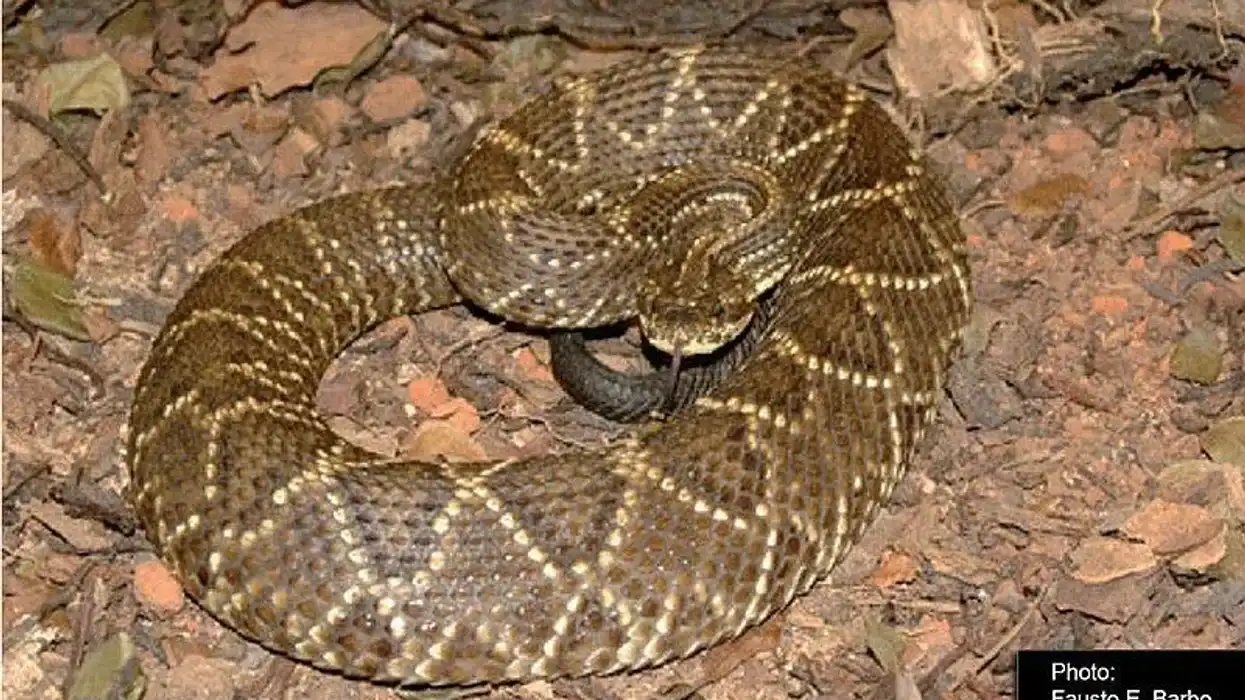The black serval, or Leptailurus serval, is a small wild cat. In other words, it is a normal serval cat that suffers from melanism. First described in 1776, the black serval has since been spotted very few times and is native to Southern Africa only.
These felines are carnivorous and prey on smaller animals. However, they are also known to eat grass, which helps with their digestion by acting as an emetic. They are in the habit of storing food for harsher times.
Their main predators include hyenas and wild dogs. On the whole, servals are agile hunters and extremely aware of their surroundings at all times.
Females raise the kittens alone and frequently change location. When accosted by a predator, they run in a zig-zag pattern, changing directions often to confuse them. Other threats include poaching for obtaining serval skin, though poachers are being heavily persecuted.
Around farmlands, they are often killed by farmers or pastors as they fear the cat will eat their livestock. In ancient Egypt, servals were believed to be gifts from the kingdom of Nubia.
If this article interests you, then check out these bombay cat facts and ringtail cat facts.
Black Serval Interesting Facts
What type of animal is a black serval?
Black servals are wild African cats.
What class of animal does a black serval belong to?
The black serval cats belong to the class of Mammalia
How many black servals are there in the world?
There is no exact estimate of the total number of black servals in the world. In 2011, the density of servals in Luambe National Park in Zambia was 0.1 animals/km². Among these, Von Hagen states that around 46% have melanism, that is, they are black servals.
Where does a black serval live?
The black serval species is found in the countries of sub-Saharan Africa. This includes Angola, Ghana, Liberia, Zimbabwe, Rwanda, Kenya, Tanzania, and more. They are not found in North Africa, though they are found on higher altitudes like that of Mount Kilimanjaro for up to 12,500 ft (3,800 m).
What is a black serval habitat?
The serval Leptailurus mostly dwells in grasslands, moorlands, and open ground. They are not found within the rainforest of Africa. Their hangout spots usually include places close to a water body with reeds and bamboo thickets. They are tolerant of farmlands however are not easily spotted. They thrive in the national parks and other reserved woodland regions.
Who does black serval live with?
Black servals are extremely territorial and mark their spaces out with saliva and feces. Females live alone, however, males may congregate at the end of the day to rest in groups.
How long does a black serval live?
A black serval usually has a life span of 10 years. Their lifespan is reduced when they are in the wild, but they can live for around 20 years if kept in captivity.
How do they reproduce?
Servals become sexually mature at around 15-24 months after their birth. Servals do not have a specific mating season.
They can reproduce at any time of the year with a spike in the wet season. A male may have a territory that overlaps with that of other females but they usually remain alone until breeding season.
Female servals go through an Oestrus cycle (hormone production that causes physiological changes) three to four times a year. During this time, they roam around restlessly while vibrating their tail and spraying their urine on objects. When she finds a suitable male, she will rub her cheek against theirs.
The gestation period is around two months, and 1-5 kittens are born at once. These young born servals will have their eyes closed, and will grow almost twice in size in a period of two weeks.
These young wild cats will be ready for the wildlife after six to eight months but will stay with their mother for at least a year before leaving them. The mother will take care of the kids alone.
What is their conservation status?
The IUCN classifies the servals as an animal of Least Concern. In Northern Africa, they fall under the Red List Criteria for Endangered. The black servals are rarer than the regular, spotted servals.
Hunting them is prohibited by law in most southern African countries. Servals mostly occur within protected forests and reserves. Their main threat lies in the loss of wetland habitat.
Black Serval Fun Facts
What does black serval look like?
A black serval cat looks similar to a normal serval cat in most aspects. However, a genetic disorder called melanism adds dark pigmentation to their coat, just like in the case of a black panther.
They have a slim body, pitch-black fur coat, large ears, a short tail, and long, limber legs. In fact, servals have the largest leg-to-body ratio of any cat. This black cat has yellow eyes with black irises and is often seen hiding in reed beds.

*Please note that this is an image of a serval, not a black serval. If you have an image of a black serval, please let us know at hello@kidadl.com.
How cute are they?
Like any other cat, servals are cute because of their small faces and large ears, but since most of them are from the wild, they are not as friendly as a Maine coon or a Persian cat. Their fluffy tail also adds to their overall cat-like vibe.
How do they communicate?
These felines have quite large ears which are not just for show! Their ears are highly sensitive to noise and can detect prey from far away. These wild cats generally communicate via voice. They emit a variety of sounds like purrs, high-pitched "miaows" when looking for a mate, growls, and nasal "mwa-mwa" sounds.
How big is a black serval?
A serval cat with melanism is the same size as a normal serval, which is around 23-36 in (59-92 cm ) long. Their body size is usually double the size of a normal Maine coon cat.
How fast can a black serval run?
To hunt prey like rodents, reptiles, birds, and birds, a serval cat needs to be stealthy and quick. They can run as fast as 43 mph (69 kph) and also jump as high as 12 ft (3m) vertically in the air.
How much does a black serval weigh?
A fully grown adult black serval cat weighs around 20-40 lb (9-18kg).
What are the male and female names of the species?
Both males and females of the species are called servals.
What would you call a baby black serval?
A newborn baby serval is known as a kitten.
What do they eat?
Black serval cats are carnivorous. Their diet includes a variety of prey like small rodents, insects, birds, and reptiles. They are good swimmers and can catch frogs and other amphibians from waterbodies.
Are they dangerous?
A wild black serval cat is dangerous for its prey but is not a danger to an adult human. Servals have the highest kill rate among all cat species which is 50%. These cats are shy and more likely to flee from any human confrontation that attacks.
Would they make a good pet?
Servals are wild animals and protected by law. However, some countries do allow black servals to be kept as exotic pets, though they are quite expensive to get and maintain. These cats will need an entire enclosure made only for themselves. They cannot be kept within the house.
The f3 or f4 generations of a serval cat are generally recommended for houses. Overall, servals are wild and known as great hunters. It is best to leave them in the wild and especially not keep them around children.
Did you know...
A serval cat can cost around $3000-$5000 to obtain. A breeder will have to spend around $10000 for two females and wait 2-3 years for the first kitten.
After that, their daily expense could be up to $5, so it would cost around $2000 to maintain a serval cat for a year.
Serval cats also need an environment similar to their natural habitat; they need a lot of space and warm temperatures. One cannot feed them usual cat food; they need a diet similar to their wildlife, such as raw chicken/turkey, or seafood.
What are servals known for?
Regular servals are also known as the giraffe cat because of their physical attributes, such as their fur with spots, elongated neck, small head, short tail, and long legs. They are usually known for their hunting style, their legs can generate enough power to throw their body high in the air to hunt birds.
This also helps them gain momentum while hunting other ground preys. In West Africa, servals form an important part of the culture as they are required for traditional medicine practices.
Do servals like water?
Unlike other cats, servals like to play in the water and are great swimmers. They like to settle close to wetlands with tall grass and bushy areas. Servals also like to hunt in water; they generally look for frogs or fishes and catch them with their paws. In an hour, a serval can catch up to 30 frogs.
Here at Kidadl, we have carefully created lots of interesting family-friendly animal facts for everyone to discover! For more relatable content, check out these caribou facts and tamarin monkey facts for kids.
You can even occupy yourself at home by coloring in one of our free printable serval cat coloring pages.










